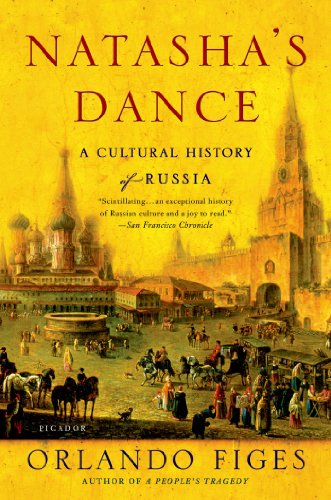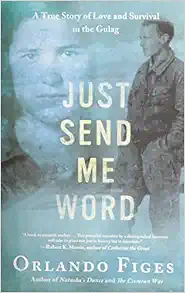
Description
From Publishers Weekly Even if one takes nothing else away from this elegant, tightly focused survey of Russian culture, it's impossible to forget the telling little anecdotes that University of London history professor Figes (A People's Tragedy) relates about Russia's artists, writers, musicians, intellectuals and courtiers as he traces the cultural movements of the last three centuries. He shares Ilya Repin's recollection of how peasants reacted to his friend Leo Tolstoy's fumbling attempts to join them in manual labor ("Never in my life have I seen a clearer expression of irony on a simple peasant's face"), as well as the three sentences Shostakovich shyly exchanged with his idol, Stravinsky, when the latter returned to the Soviet Union after 50 years of exile (" `What do you think of Puccini?' `I can't stand him,' Stravinsky replied. `Oh, and neither can I, neither can I' "). Full of resounding moments like these, Figes's book focuses on the ideas that have preoccupied Russian artists in the modern era: Just what is "Russianness," and does the quality come from its peasants or its nobility, from Europe or from Asia? He examines canonical works of art and literature as well as the lives of their creators: Tolstoy, Tchaikovsky, Chagall, Stanislavsky, Eisenstein and many others. Figes also shows how the fine arts have been influenced by the Orthodox liturgy, peasant songs and crafts, and myriad social and economic factors from Russian noblemen's unusual attachments to their peasant nannies to the 19th-century growth of vodka production. The book's thematically organized chapters are devoted to subjects like the cultural influence of Moscow or the legacy of the Mongol invasion, and with each chapter Figes moves toward the 1917 revolution and the Soviet era, deftly integrating strands of political and social history into his narrative. This is a treat for Russophiles and a unique introduction to Russian history.Copyright 2002 Cahners Business Information, Inc. --This text refers to an alternate kindle_edition edition. “Scintillating. . .an exceptional history of Russian culture and a joy to read.” ― San Francisco Chronicle “Stunning and ambitious. . .Figes captures nothing less than Russians' complex and protean notions regarding their national identity.” ― The Atlantic Monthly “Staggering. . .A vivid, entertaining, and enlightening account of what it has meant to be culturally a Russian over the last three centuries.” ― Los Angeles Times “[A] masterly work.” ― New York Review of Books “A big, bold, interpretative cultural history.” ― Foreign Affairs --This text refers to an alternate kindle_edition edition. From Booklist The author of A People's Tragedy (1997) takes on the massive task of giving historical perspective to Russian culture and is--for the most part--successful. He manages fairly well to balance hundreds of great names, from Pushkin to Nabokov, with those that are less known to the general public, although he gives short shrift to early twentieth-century Silver Age writers like Blok and Bely. The Futurists, with the exception of Mayakovsky, are barely mentioned. Against this history-by-personality Figes contrasts European St. Petersburg and Russian Moscow. Large sections treat the cultural influences of the peasantry, the Mongols, and the Orthodox Church. The chapter on the Soviet period is elegiac (to put it mildly), and there's a wistfulness to the chapter on Russian emigre culture in Berlin and Paris. However, other than mentioning film director Andrei Tarkovsky, Figes doesn't seem to care much about Russian culture of the past 40 years. Perhaps a second volume is forthcoming that will document the history of Russian culture into the twenty-first century. Frank Caso Copyright © American Library Association. All rights reserved --This text refers to an alternate kindle_edition edition. Excerpt. © Reprinted by permission. All rights reserved. From N atasha's Dance :"With the shift of political power to St. Petersburg, Moscow became the capital of the good life for the nobility. Its grandees gave themselves to sensual amusement. Count Rakhmanov, for example, spent his whole inheritance in eight years of gastronomy. He fed his poultry with truffles. He kept his crayfish in cream and parmesan instead of water. And he had his favorite fish, found only in the Sosna River a thousand miles away, delivered live to Moscow every day. Count Stroganov gave 'Roman dinners'—his guests lay on couches and were served by naked boys. Caviar and herring cheeks were typical hors d'oeuvres. Next came salmon lips, bear paws, and roast lynx. Then they had cuckoos roasted in honey, halibut liver, and burbot roe; oysters, poultry, and fresh figs; salted peaches and pineapples. Afterward, they would go into the banya and drink, eating caviar to build up a real thirst . . . Petersburgers despised Moscow for its sinful idleness, yet no one could deny its Russian character." --This text refers to an alternate kindle_edition edition. Orlando Figes is Professor of History at Birkbeck College, University of London. Born in London in 1959, he graduated with a Double-Starred First from Cambridge University, where he was a Lecturer in History and Fellow of Trinity College from 1984 to 1999. He is the author of many books on Russian history. --This text refers to an alternate kindle_edition edition. From Library Journal Figes (history, Univ. of London; A People's Tragedy) describes the twists and turns of Russian history through cultural and artistic events from the founding of Rus in the 12th century through the Soviet era. He uses Tolstoy's War and Peace as a centerpiece of art imitating life. The title of Figes's book comes from the scene in which Natasha Rostov and her brother Nikolai are invited by their "uncle" to a rustic cabin to listen to him play Russian folk music on his guitar. Natasha instinctively begins a folk dance that is prompted by "unknown feelings in her heart." Tolstoy would have us believe that "Russia may be held together by unseen threads of native sensibilities," writes Figes. Nowhere is the clash between the European culture of the upper class and the Russian culture of the peasantry more evident. "The complex interactions between these two worlds had a crucial influence on the national consciousness and on all the arts of the 19th century." This interaction is a major feature of this book, which traces the formation of a culture. The writing style is distinctly nonacademic, making for a very enjoyable read. Recommended for academic and public libraries. Harry Willems, Southeast Kansas Lib. Syst., IolaCopyright 2002 Reed Business Information, Inc. --This text refers to an alternate kindle_edition edition. Read more
Features & Highlights
- History on a grand scale--an enchanting masterpiece that explores the making of one of the world's most vibrant civilizations
- A People's Tragedy
- , wrote Eric Hobsbawm, did "more to help us understand the Russian Revolution than any other book I know." Now, in
- Natasha's Dance
- , internationally renowned historian Orlando Figes does the same for Russian culture, summoning the myriad elements that formed a nation and held it together.Beginning in the eighteenth century with the building of St. Petersburg--a "window on the West"--and culminating with the challenges posed to Russian identity by the Soviet regime, Figes examines how writers, artists, and musicians grappled with the idea of Russia itself--its character, spiritual essence, and destiny. He skillfully interweaves the great works--by Dostoevsky, Stravinsky, and Chagall--with folk embroidery, peasant songs, religious icons, and all the customs of daily life, from food and drink to bathing habits to beliefs about the spirit world. Figes's characters range high and low: the revered Tolstoy, who left his deathbed to search for the Kingdom of God, as well as the serf girl Praskovya, who became Russian opera's first superstar and shocked society by becoming her owner's wife. Like the European-schooled countess Natasha performing an impromptu folk dance in Tolstoy's
- War and Peace
- , the spirit of "Russianness" is revealed by Figes as rich and uplifting, complex and contradictory--a powerful force that unified a vast country and proved more lasting than any Russian ruler or state.




